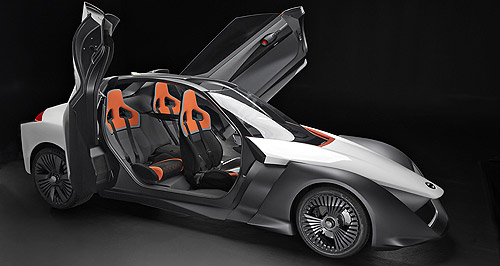Future models - Nissan - BladeGliderNissan BladeGlider prototype surfaces in RioTokyo show concept evolves into working Nissan BladeGlider prototype in Brazil5 Aug 2016 NISSAN’S radical zero-emissions BladeGlider concept had taken another step towards the possibility of a production three-seater sportscar, with a functioning prototype breaking cover in Rio de Janeiro. At this latest stage in the development, the Japanese car-maker says the arrowhead-shaped electric car is still a ‘study’ but its performance is very real, with the “near-silent” drivetrain capable of launching the car from zero to 100km/h in less than five seconds and on to a top speed of 190km/h. Its unorthodox approach of a narrow frontal area and wider tail has also been in the Nissan DeltaWing racecar at the Le Mans 24-hour race in 2012, but the layout returned in a road-car concept at the Tokyo show the following year. Since then the concept has reappeared in an evolved form at the New York show in 2014, but the BladeGlider is now a fully functioning car – “the EV for car lovers”, says Nissan. Creating the functioning prototype required a global effort from Nissan’s various centres of specialisation including a major contribution by UK-based Williams Advanced Engineering, but if a production version does emerge, it is possible it could have Australian involvement. The BladeGlider’s brace of 130kW motors and 220kW lithium-ion battery have “bespoke cooling systems” – a component that the Nissan Casting Australia Plant specialises in for other EVs including the Leaf and several unidentified new models. The Dandenong-based plant currently only produces components for production Nissan and Infiniti models so it is unlikely the BladeGlider prototype has any kangaroo-stamped parts but that is not out of the question if it is given the green light. Nissan Motor Company president and CEO Carlos Ghosn said the experimental car is the epitome of its Intelligent Mobility philosophy, which aims to make its vehicles more exciting by redefining the way they are driven, powered and integrated into society. “These prototypes epitomise Nissan’s drive to expand its Intelligent Mobility strategy, where driving pleasure combines with environmental responsibility,” he said. “Nissan believes that enthusiasts should look forward to a zero emission future and BladeGlider is a perfect demonstration of that. It’s the electric vehicle for car-lovers.” Stop and start traffic and the urban environment is the natural habitat for most electric vehicles with high-speeds diminishing range, but the BladeGlider’s curious shape minimises front cross-sectional area which reduces drag for both performance and efficiency optimisation. The wider rear track also promotes handling stability, says Nissan. Other notable physical features include the rearward opening dihedral doors that are unique to the BladeGlider, while the open top provides the fun of a convertible but the safety of a coupe thanks to a rollover protection structure, says Nissan. The wedge shape requires a different arrangement inside the BladeGlider with an uncommon three seat layout that puts the driver front and centre, flanked by two rear passengers at either side. The layout has not been seen in a production car since the iconic McLaren F1. All three occupants are pinned in position by four-point harnesses and an unusual upholstery that uses epoxy resin and “highly tactile blend of fabric”. At the helm, the driver has four digital displays – two central screens for vehicle information, while two at either side replace the role of door mirrors, displaying images from a pair of rear-facing cameras. In pure sportscar tradition, the prototype is rear drive and has three ESC modes – Agile, Drift and off, while torque vectoring counters understeer and helps keep the BladeGlider pointing in the correct direction by sharing power between the pair of rear axle motors. A pair of the prototypes will be on show in Rio decorated in two colour schemes of Cyber Green and Stealth Orange, with one car used for a static display, while the other will be providing a dynamic demonstration with rides for the media and VIPs.  Read more |
Click to shareNissan modelsResearch Nissan Motor industry news |

































Facebook Twitter Instagram